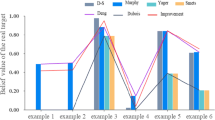Abstract
This paper addresses the combination of unreliable evidence sources which provide uncertain information in the form of basic probability assignment (BPA) functions. We proposed a novel evidence combination rule based on credibility and non-specificity of belief functions. Following a review of all existing non-specificity measures in evidence theory, a non-specificity measure for evidence theory is discussed. It is claimed that the non-specificity degree of a BPA is related to its ability of pointing to one and only one element. Based on the difference between the largest belief grades and other belief grades, a non-specificity measure is defined. Properties of the proposed non-specificity measure are put forward and proved mathematically. Illustrative examples are employed to show the properties of non-specificity measure. After providing a procedure for the evaluation of evidence credibility, we propose a novel evidence combination rule. Numerical example and application in target identification are applied to demonstrate the performance of our proposed evidence combination rule.


Similar content being viewed by others
References
Dempster AP (1967) Upper and lower probabilities induced by a multiple valued mapping. Ann Math Stat 38(2):325–339
Shafer G (1976) A mathematical theory of evidence. Princeton University Press, Princeton
Liu Z-G, Pan Q, Dezert J, Martin A (2016) Adaptive imputation of missing values for incomplete pattern recognition. Pattern Recogn 52(1):85–95
Smarandache F, Dezert J (2009) Applications and advances of DSmT for information fusion, vol 3. American Research Press, Rehoboth, pp 4–32
Lefevre E, Colot O, Vannoorenberghe P (2002) Belief functions combination and conflict management. Inf Fusion 3(2):149–162
Smets P (2000) Data fusion in the transferable belief model. In: Proceedings of the 3rd international conference on information fusion, Paris, France, pp PS21–PS33
Florea MC, Jousselme A-L, Bosse E (2009) Robust combination rules for evidence theory. Inf Fusion 10(2):183–197
Liu Z-G, Pan Q, Dezert J (2014) A belief classification rule for imprecise data. Appl Intell 40(2):214–228
Yager RR (1987) On the Dempster–Shafer framework and new combination rules. Inf Sci 41(2):93–137
Haenni R (2005) Shedding new light on Zadeh’s criticism of Dempster’s rule of combination. In: Proceedings of the eighth international conference on information fusion, Philadelphia, USA. IEEE, Piscataway, pp 879–884
Murphy CK (2000) Combining belief functions when evidence conflicts. Decis Support Syst 29(1):1–9
Deng Y, Shi WK, Zhu ZF, Liu Q (2004) Combining belief functions based on distance of evidence. Decis Support Syst 38(3):489–493
Klein J, Colot O (2010) Automatic discounting rate computation using a dissent criterion. In: Proceedings of the workshop on the theory of belief functions, Brest, France, pp 1–6
Yang Y, Han D, Han C (2013) Discounted combination of unreliable evidence using degree of disagreement. Int J Approx Reason 54(8):1197–1216
Elouedi Z, Mellouli K, Smets P (2004) Assessing sensor reliability for multisensor data fusion within the transferable belief model. IEEE Trans Syst Man Cybern B Cybern 34(4):782–787
Guo H, Shi W, Deng Y (2006) Evaluating sensor reliability in classification problems based on evidence theory. IEEE Trans Syst Man Cybern B Cybern 36(5):970–981
Schubert J (2011) Conflict management in Dempster–Shafer theory using the degree of falsity. Int J Approx Reason 52(3):449–460
Jousselme A-L, Grenier D, Bosse E (2001) A new distance between two bodies of evidence. Inf Fusion 2(2):91–101
Liu Z-G, Dezert J, Pan Q, Mercier G (2011) Combination of sources of evidence with different discounting factors based on a new dissimilarity measure. Decis Support Syst 52(1):133–141
Guo K, Li W (2011) Combination rule of D–S evidence theory based on the strategy of cross merging between evidences. Expert Syst Appl 38(10):13360–13366
Smets P, Kennes R (1994) The transferable belief model. Artif Intell 66(2):191–243
Klir GJ, Yuan B (1995) Fuzzy sets and fuzzy logic: theory and applications. Prentice-Hall, Upper Saddle River
Hartley RVL (1928) Transmission of information. Bell Syst Technol J 7:535–563
Shannon CE (1948) A mathematical theory of communication. Bell Syst Technol J 27:623–656
Jousselme A-L, Liu C, Grenier D, Bosse E (2006) Measuring ambiguity in the evidence theory. IEEE Trans Syst Man Cybern A Syst Hum 36(5):890–903
Dubois D, Prade H (1985) A note on measures of specificity for fuzzy sets. Int J Gen Syst 10(4):279–283
Yager RR (1982) Measuring tranquility and anxiety in decision making: an application of fuzzy sets. Int J Gen Syst 8:139–146
Yager RR (1981) Measurement of properties of fuzzy sets and possibility distributions. In: Proceedings of third international seminar on fuzzy sets, Linz, pp 211–222
Yager RR (1983) Entropy and specificity in a mathematical theory of evidence. Int J Gen Syst 9(4):249–260
Yager RR (2009) Some aspects of intuitionistic fuzzy sets. Fuzzy Optim Decis Mak 8(1):67–90
Song Y, Wang X, Lei L, Xue A (2014) Combination of interval-valued belief structures based on intuitionistic fuzzy set. Knowl Based Syst 67(9):61–70
Song Y, Wang X, Lei L, Xue A (2014) Measurement of evidence conflict based on correlation coefficient. J Commun 35(5):95–100
Author information
Authors and Affiliations
Corresponding author
Rights and permissions
About this article
Cite this article
Song, Y., Wang, X., Wu, W. et al. Evidence combination based on credibility and non-specificity. Pattern Anal Applic 21, 167–180 (2018). https://doi.org/10.1007/s10044-016-0575-6
Received:
Accepted:
Published:
Issue Date:
DOI: https://doi.org/10.1007/s10044-016-0575-6




